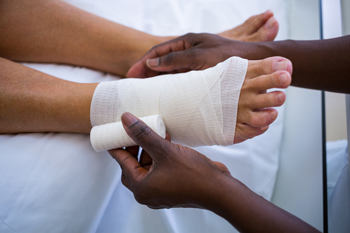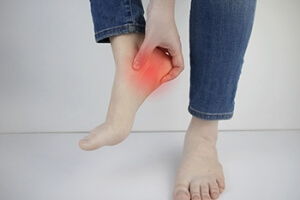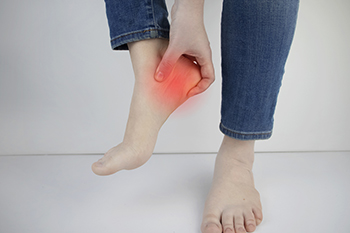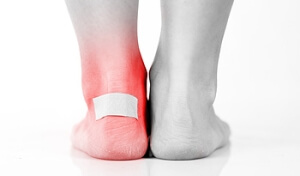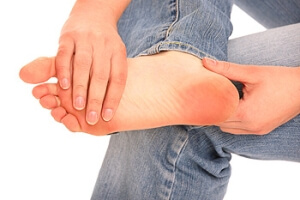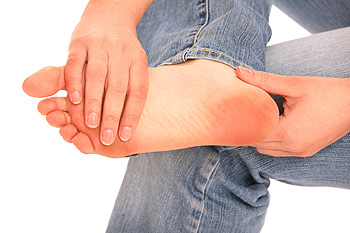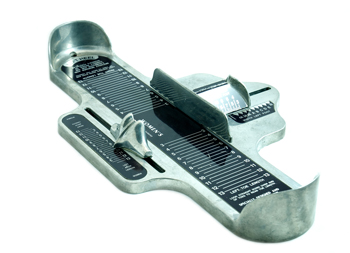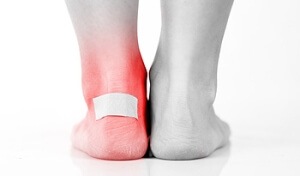Super User
When the Wound on Your Foot Becomes an Ulcer
Wounds can occur on the feet from an injury, poor circulation, prolonged pressure from improperly fitted shoes, or complications from diseases like diabetes, neuropathy, and vascular disease. Over time, if these wounds do not close and the underlying tissue becomes affected, they are considered ulcers. These types of wounds are potentially dangerous – particularly in people with diabetes. Ulcers can lead to infections in the bone and skin. You can sometimes tell if the wound on your foot has become an ulcer if it is draining, emits a foul odor, or the tissue has become thickened, inflamed, or red. It is important to seek the professional wound care that a podiatrist can provide to help heal the wound and prevent more serious complications from developing. Podiatrists typically begin by cleaning the wound and removing any unhealthy tissue, termed debridement. Antibiotics may be prescribed if an infection is present. They may also suggest certain shoes and orthotics that will keep pressure off the wound and, in severe cases, perform surgery and other methods of wound care.
Wound care is an important part in dealing with diabetes. If you have diabetes and a foot wound or would like more information about wound care for diabetics, consult with one of our podiatrists from New Tampa Foot & Ankle. Our doctors will assess your condition and provide you with quality foot and ankle treatment.
What Is Wound Care?
Wound care is the practice of taking proper care of a wound. This can range from the smallest to the largest of wounds. While everyone can benefit from proper wound care, it is much more important for diabetics. Diabetics often suffer from poor blood circulation which causes wounds to heal much slower than they would in a non-diabetic.
What Is the Importance of Wound Care?
While it may not seem apparent with small ulcers on the foot, for diabetics, any size ulcer can become infected. Diabetics often also suffer from neuropathy, or nerve loss. This means they might not even feel when they have an ulcer on their foot. If the wound becomes severely infected, amputation may be necessary. Therefore, it is of the upmost importance to properly care for any and all foot wounds.
How to Care for Wounds
The best way to care for foot wounds is to prevent them. For diabetics, this means daily inspections of the feet for any signs of abnormalities or ulcers. It is also recommended to see a podiatrist several times a year for a foot inspection. If you do have an ulcer, run the wound under water to clear dirt from the wound; then apply antibiotic ointment to the wound and cover with a bandage. Bandages should be changed daily and keeping pressure off the wound is smart. It is advised to see a podiatrist, who can keep an eye on it.
If you have any questions, please feel free to contact our office located in Wesley Chapel, FL . We offer the newest diagnostic and treatment technologies for all your foot care needs.
What Leads to the Most Common Type of Heel Pain
If you have pain on the bottom of your foot in the heel/arch area, you may be experiencing plantar fasciitis. This is a condition where the connective tissue spanning the bottom of your foot (plantar fascia) becomes irritated and inflamed, and sometimes even torn. Plantar fasciitis can occur for a variety of reasons. Being obese, working on your feet all day, or wearing shoes with inadequate heel support can all put undue stress on the plantar fascia tissue. Also, with older age, both the plantar fascia tissue and fat heel pads wear down and may lead to plantar fasciitis. Other contributing factors such as wearing high heels, having flat feet, high arches, or problems with posture or gait may contribute to this painful condition developing. Podiatrists treat plantar fasciitis patients frequently and very successfully, as it is the most common form of heel pain. Treatments may include resting, icing, shoe modifications and custom orthotics, pain relievers, and possibly even night splints to keep the Achilles heel and plantar fasciitis stretched and the arch supported. A podiatrist may treat pain and help heal damaged tissue in more severe cases of plantar fasciitis with corticosteroid injections, sound wave or ultrasound therapy, or in worst case scenarios, surgical intervention.
Plantar fasciitis is a common foot condition that is often caused by a strain injury. If you are experiencing heel pain or symptoms of plantar fasciitis, contact one of our podiatrists from New Tampa Foot & Ankle. Our doctors can provide the care you need to keep you pain-free and on your feet.
What Is Plantar Fasciitis?
Plantar fasciitis is one of the most common causes of heel pain. The plantar fascia is a ligament that connects your heel to the front of your foot. When this ligament becomes inflamed, plantar fasciitis is the result. If you have plantar fasciitis you will have a stabbing pain that usually occurs with your first steps in the morning. As the day progresses and you walk around more, this pain will start to disappear, but it will return after long periods of standing or sitting.
What Causes Plantar Fasciitis?
- Excessive running
- Having high arches in your feet
- Other foot issues such as flat feet
- Pregnancy (due to the sudden weight gain)
- Being on your feet very often
There are some risk factors that may make you more likely to develop plantar fasciitis compared to others. The condition most commonly affects adults between the ages of 40 and 60. It also tends to affect people who are obese because the extra pounds result in extra stress being placed on the plantar fascia.
Prevention
- Take good care of your feet – Wear shoes that have good arch support and heel cushioning.
- Maintain a healthy weight
- If you are a runner, alternate running with other sports that won’t cause heel pain
There are a variety of treatment options available for plantar fasciitis along with the pain that accompanies it. Additionally, physical therapy is a very important component in the treatment process. It is important that you meet with your podiatrist to determine which treatment option is best for you.
If you have any questions, please feel free to contact our office located in Wesley Chapel, FL . We offer the newest diagnostic and treatment technologies for all your foot care needs.
Why Does My Foot Hurt?
 Foot pain can hinder everyday life, and it develops from a variety of causes. Foot pain can occur due to injuries such as sprains, strains, and fractures. Foot pain can also happen due to various medical conditions. One common condition, known as gout, is a form of arthritis that causes pain and inflammation from a high concentration of uric acid in the blood. Another foot issue that one may experience is a bunion, which is a bony protrusion that forms at the base of the big toe. If you’re suffering from heel pain, this may be the result of plantar fasciitis. This occurs when the plantar fascia, which connects the heel bone to the toes, becomes inflamed or partially torn. Morton's neuroma is another ailment that can cause foot pain. This develops when the nerve in the foot becomes compressed and irritated. If you are struggling with any type of foot pain, it is highly suggested that you consult with a podiatrist for a professional diagnosis.
Foot pain can hinder everyday life, and it develops from a variety of causes. Foot pain can occur due to injuries such as sprains, strains, and fractures. Foot pain can also happen due to various medical conditions. One common condition, known as gout, is a form of arthritis that causes pain and inflammation from a high concentration of uric acid in the blood. Another foot issue that one may experience is a bunion, which is a bony protrusion that forms at the base of the big toe. If you’re suffering from heel pain, this may be the result of plantar fasciitis. This occurs when the plantar fascia, which connects the heel bone to the toes, becomes inflamed or partially torn. Morton's neuroma is another ailment that can cause foot pain. This develops when the nerve in the foot becomes compressed and irritated. If you are struggling with any type of foot pain, it is highly suggested that you consult with a podiatrist for a professional diagnosis.
Foot Pain
Foot pain can be extremely painful and debilitating. If you have a foot pain, consult with one of our podiatrists from New Tampa Foot & Ankle. Our doctors will assess your condition and provide you with quality foot and ankle treatment.
Causes
Foot pain is a very broad condition that could be caused by one or more ailments. The most common include:
- Bunions
- Hammertoes
- Plantar Fasciitis
- Bone Spurs
- Corns
- Tarsal Tunnel Syndrome
- Ingrown Toenails
- Arthritis (such as Gout, Rheumatoid, and Osteoarthritis)
- Flat Feet
- Injury (from stress fractures, broken toe, foot, ankle, Achilles tendon ruptures, and sprains)
- And more
Diagnosis
To figure out the cause of foot pain, podiatrists utilize several different methods. This can range from simple visual inspections and sensation tests to X-rays and MRI scans. Prior medical history, family medical history, and any recent physical traumatic events will all be taken into consideration for a proper diagnosis.
Treatment
Treatment depends upon the cause of the foot pain. Whether it is resting, staying off the foot, or having surgery; podiatrists have a number of treatment options available for foot pain.
If you have any questions, please feel free to contact our office located in Wesley Chapel, FL . We offer the newest diagnostic and treatment technologies for all your foot care needs.
What Causes Blisters and Why They Form
Blisters form between layers of injured skin as a way of cushioning the injury and protecting it from further damage. When friction or some other irritant damages the upper layer of skin (epidermis), it can tear away from underlying layers of skin. The space that is created between the layers then fills up with fluid (serum). Most blisters occur as a result of friction caused by ill-fitting shoes or socks. Other causes of blisters include burns, frostbite, irritants such as insect bites, chemicals and other toxins. Medical conditions like diabetic neuropathy and eczema, as well as certain autoimmune deficiencies, can weaken the outer layer of skin which increases the risk of blisters forming. Aside from removing pressure from the affected area, it is best to leave a blister alone to allow it to heal naturally, which usually happens within a few days. However, if the blister worsens by becoming discolored or excessively inflamed, it may indicate that an infection is present and a podiatrist should be consulted right away.
Blisters are prone to making everyday activities extremely uncomfortable. If your feet are hurting, contact one of our podiatrists of New Tampa Foot & Ankle. Our doctors can provide the care you need to keep you pain-free and on your feet.
Foot Blisters
Foot blisters develop as a result of constantly wearing tight or ill-fitting footwear. This happens due to the constant rubbing from the shoe, which can often lead to pain.
What Are Foot Blisters?
A foot blister is a small fluid-filled pocket that forms on the upper-most layer of the skin. Blisters are filled with clear fluid and can lead to blood drainage or pus if the area becomes infected.
How Do Blisters Form?
Blisters on the feet are often the result of constant friction of skin and material, usually by shoe rubbing. Walking in sandals, boots, or shoes that don’t fit properly for long periods of time can result in a blister. Having consistent foot moisture and humidity can easily lead to blister formation.
Prevention & Treatment
It is important to properly care for the affected area in order to prevent infection and ease the pain. Do not lance the blister and use a Band-Aid to provide pain relief. Also, be sure to keep your feet dry and wear proper fitting shoes. If you see blood or pus in a blister, seek assistance from a podiatrist.
If you have any questions, please feel free to contact our office located in Wesley Chapel, FL . We offer the newest diagnostic and treatment technologies for all your foot care needs.
Why Do I Get Foot Cramps?
Foot cramps are spasms that occur in the muscles of the feet, most typically on the top of the foot, in the arch, and surrounding the toes. These spasms can be quite painful and may even lock your muscles and prevent movement until they subside. Foot cramps that occur occasionally are likely no cause for alarm, but if they are chronic and interfere with your ability to perform daily functions, you should go see a podiatrist to have them diagnosed. Possible causes of foot cramps can include dehydration, which starves muscles and causes them to malfunction, tight shoes that cut off circulation and restrict movement, peripheral neuropathy (nerve damage), certain medications, and excessive exercising which strains the foot muscles. Additionally, insufficient amounts of potassium in your body—which controls nerve and muscle cell functionality—may contribute to foot cramping. If foot cramps are becoming frequent or more severe, contact a podiatrist.
Foot Pain
Foot pain can be extremely painful and debilitating. If you have a foot pain, consult with one of our podiatrists from New Tampa Foot & Ankle. Our doctors will assess your condition and provide you with quality foot and ankle treatment.
Causes
Foot pain is a very broad condition that could be caused by one or more ailments. The most common include:
- Bunions
- Hammertoes
- Plantar Fasciitis
- Bone Spurs
- Corns
- Tarsal Tunnel Syndrome
- Ingrown Toenails
- Arthritis (such as Gout, Rheumatoid, and Osteoarthritis)
- Flat Feet
- Injury (from stress fractures, broken toe, foot, ankle, Achilles tendon ruptures, and sprains)
- And more
Diagnosis
To figure out the cause of foot pain, podiatrists utilize several different methods. This can range from simple visual inspections and sensation tests to X-rays and MRI scans. Prior medical history, family medical history, and any recent physical traumatic events will all be taken into consideration for a proper diagnosis.
Treatment
Treatment depends upon the cause of the foot pain. Whether it is resting, staying off the foot, or having surgery; podiatrists have a number of treatment options available for foot pain.
If you have any questions, please feel free to contact our office located in Wesley Chapel, FL . We offer the newest diagnostic and treatment technologies for all your foot care needs.
Buying Shoes That Feel Comfortable
By wearing shoes that fit well, you can prevent the development of many foot conditions such as bunions, corns, calluses, hammertoes, blisters, ingrown toenails, plantar fasciitis, Morton’s neuroma and more. Start by knowing your true size. You may think your feet are the same size as they were a few years ago, however, age, changes in weight, and other factors may cause your feet to grow and expand. Have your feet measured every time you buy shoes—both in length and width. Make sure you try shoes on at the end of the day, after your feet have expanded. Check for ⅜” to ½” of space between the tip of the shoe and your big toe, and that the ball of your feet don’t feel squeezed. Don’t buy shoes that feel uncomfortable thinking they will expand, or that you will wear them in later. Walk around the store for a while to get a real sense of their fit. Make sure you don’t slip around in them or that they cause friction by rubbing against your feet, toes, back of your heel, etc. If you are struggling to find the shoes with the right fit for you, a podiatrist can offer additional tips for buying shoes that are appropriate for your particular feet.
Getting the right shoe size is an important part of proper foot health. Seek the assistance of one of our podiatrists from New Tampa Foot & Ankle. Our doctors will provide the care you need to keep you pain-free and on your feet.
Getting the Right Shoe Size
There are many people who wear shoes that are the incorrect size, negatively affecting their feet and posture. Selecting the right shoes is not a difficult process, so long as you keep several things in mind when it comes to choosing the right pair.
- When visiting the shoe store, use the tools available to measure your foot.
- Be sure there is ‘wiggle room’. There should be about an inch between your toes and the tip of your shoes.
- Do not always assume you are the same size, as manufacturers run differently.
- Purchase shoes later in the day, as your feet swell as the day progresses.
- If a shoe is not comfortable, it is not suitable. Most shoes can’t be ‘broken in’, and comfort should be the ultimate goal when it comes to choosing the right pair of shoes
As our feet hold our body weight and keep us moving, it is important to treat them right. Picking the right pair of shoes can provide your feet comfort and mobility without pain.
If you have any questions, please feel free to contact our office located in Wesley Chapel, FL . We offer the newest diagnostic and treatment technologies for all your foot care needs.
Why Do Blisters on the Feet Develop?
When the upper layer of skin has been damaged, the body’s natural defense mechanism can form a blister for protection. It is defined as a small area that resembles a bubble and is filled with liquid that cushions that raw skin as the healing process occurs. Blisters generally develop from excessive friction and can be quite painful and uncomfortable. Wearing shoes and socks that do not fit correctly is a common cause of blisters. There are some patients who have specific medical conditions that can cause blisters. These can include eczema and psoriasis, in addition to developing an allergic reaction to an insect bite. It can be beneficial to cover the blister with a protective covering while accomplishing daily activities, which may help to prevent premature popping and draining. If you have a blister on your foot, please speak with a podiatrist who can offer you treatment techniques that can possibly avoid an infection from developing.
Blisters may appear as a single bubble or in a cluster. They can cause a lot of pain and may be filled with pus, blood, or watery serum. If your feet are hurting, contact one of our podiatrists of New Tampa Foot & Ankle. Our doctors can provide the care you need to keep you pain-free and on your feet.
Foot Blisters
Foot blisters are often the result of friction. This happens due to the constant rubbing from shoes, which can lead to pain.
What Are Foot Blisters?
A foot blister is a small fluid-filled pocket that forms on the upper-most layer of the skin. Blisters are filled with clear fluid and can lead to blood drainage or pus if the area becomes infected.
Symptoms
(Blister symptoms may vary depending on what is causing them)
- Bubble of skin filled with fluid
- Redness
- Moderate to severe pain
- Itching
Prevention & Treatment
In order to prevent blisters, you should be sure to wear comfortable shoes with socks that cushion your feet and absorb sweat. Breaking a blister open may increase your chances of developing an infection. However, if your blister breaks, you should wash the area with soap and water immediately and then apply a bandage to the affected area. If your blisters cause severe pain it is important that you call your podiatrist right away.
If you have any questions, please feel free to contact our office located in Wesley Chapel, FL . We offer the newest diagnostic and treatment technologies for all your foot care needs.
Reasons Your Feet May Hurt
Foot pain is one of the most common complaints addressed by podiatrists. Foot pain may be the result of injury, overuse, or inflammation, among other potential causes. Injuries that may cause foot pain can include Achilles tendonitis or rupture, bone fractures, plantar fasciitis, Morton’s neuroma, tarsal tunnel syndrome, and more. Injuries can occur suddenly or due to repetitive overuse. Inflammatory conditions like arthritis are also very common culprits behind foot pain. Skin conditions like corns, calluses, and plantar warts may lead to foot pain as the affected areas rub against the shoes or are put under pressure while walking or standing. Deformities such as hammertoes and bunions can also be quite painful, especially if they are severe. If you are suffering from foot pain, don’t hesitate to schedule an appointment with a podiatrist near you.
Foot Pain
Foot pain can be extremely painful and debilitating. If you have a foot pain, consult with one of our podiatrists from New Tampa Foot & Ankle. Our doctors will assess your condition and provide you with quality foot and ankle treatment.
Causes
Foot pain is a very broad condition that could be caused by one or more ailments. The most common include:
- Bunions
- Hammertoes
- Plantar Fasciitis
- Bone Spurs
- Corns
- Tarsal Tunnel Syndrome
- Ingrown Toenails
- Arthritis (such as Gout, Rheumatoid, and Osteoarthritis)
- Flat Feet
- Injury (from stress fractures, broken toe, foot, ankle, Achilles tendon ruptures, and sprains)
- And more
Diagnosis
To figure out the cause of foot pain, podiatrists utilize several different methods. This can range from simple visual inspections and sensation tests to X-rays and MRI scans. Prior medical history, family medical history, and any recent physical traumatic events will all be taken into consideration for a proper diagnosis.
Treatment
Treatment depends upon the cause of the foot pain. Whether it is resting, staying off the foot, or having surgery; podiatrists have a number of treatment options available for foot pain.
If you have any questions, please feel free to contact our office located in Wesley Chapel, FL . We offer the newest diagnostic and treatment technologies for all your foot care needs.
What Pain in the Bottom of the Foot Indicates
 Because the feet are made up of 26 bones, 30 joints, and almost 100 muscles and ligaments, there are a variety of issues that can lead to foot pain. Pain at the bottom of the foot can indicate problems such as Plantar fasciitis, metatarsalgia, or neuropathy. Plantar fasciitis is the result of the plantar fascia, the band of tissue running along the bottom of the foot from the heel to the toes, becoming inflamed. Metatarsalgia generally refers to any painful condition that affects the metatarsal region, or ball of the foot. However, the pain is normally caused because the metatarsal heads (ball of the foot) become inflamed and put more pressure on the bones at the front of the foot. Lastly, neuropathy is a result of nerve damage in the feet that can lead to a tingling, burning or stabbing sensation. If you are struggling with foot pain, consulting with a podiatrist is important in order to get a proper diagnosis and treatment plan for the issue.
Because the feet are made up of 26 bones, 30 joints, and almost 100 muscles and ligaments, there are a variety of issues that can lead to foot pain. Pain at the bottom of the foot can indicate problems such as Plantar fasciitis, metatarsalgia, or neuropathy. Plantar fasciitis is the result of the plantar fascia, the band of tissue running along the bottom of the foot from the heel to the toes, becoming inflamed. Metatarsalgia generally refers to any painful condition that affects the metatarsal region, or ball of the foot. However, the pain is normally caused because the metatarsal heads (ball of the foot) become inflamed and put more pressure on the bones at the front of the foot. Lastly, neuropathy is a result of nerve damage in the feet that can lead to a tingling, burning or stabbing sensation. If you are struggling with foot pain, consulting with a podiatrist is important in order to get a proper diagnosis and treatment plan for the issue.
Foot Pain
Foot pain can be extremely painful and debilitating. If you have a foot pain, consult with one of our podiatrists from New Tampa Foot & Ankle. Our doctors will assess your condition and provide you with quality foot and ankle treatment.
Causes
Foot pain is a very broad condition that could be caused by one or more ailments. The most common include:
- Bunions
- Hammertoes
- Plantar Fasciitis
- Bone Spurs
- Corns
- Tarsal Tunnel Syndrome
- Ingrown Toenails
- Arthritis (such as Gout, Rheumatoid, and Osteoarthritis)
- Flat Feet
- Injury (from stress fractures, broken toe, foot, ankle, Achilles tendon ruptures, and sprains)
- And more
Diagnosis
To figure out the cause of foot pain, podiatrists utilize several different methods. This can range from simple visual inspections and sensation tests to X-rays and MRI scans. Prior medical history, family medical history, and any recent physical traumatic events will all be taken into consideration for a proper diagnosis.
Treatment
Treatment depends upon the cause of the foot pain. Whether it is resting, staying off the foot, or having surgery; podiatrists have a number of treatment options available for foot pain.
If you have any questions, please feel free to contact our office located in Wesley Chapel, FL . We offer the newest diagnostic and treatment technologies for all your foot care needs.



